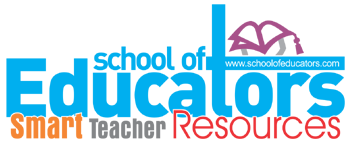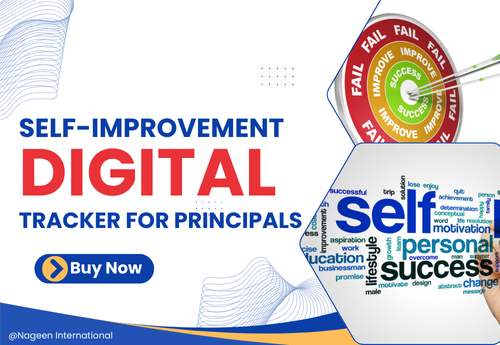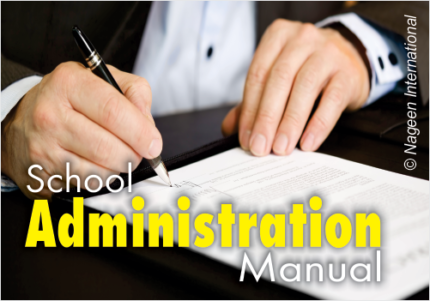Purpose of the Digital Tracker
The Self-Improvement Digital Tracker serves as a personalized leadership assessment tool that helps principals:
![]() Track Progress – Evaluate key leadership skills and performance indicators.
Track Progress – Evaluate key leadership skills and performance indicators.
![]() Identify Strengths & Areas for Growth – Understand where improvements are needed.
Identify Strengths & Areas for Growth – Understand where improvements are needed.
![]() Monitor Goal Achievement – Set SMART (Specific, Measurable, Achievable, Relevant, Time-bound) improvement goals.
Monitor Goal Achievement – Set SMART (Specific, Measurable, Achievable, Relevant, Time-bound) improvement goals.
![]() Encourage Reflective Practice – Enable self-reflection on leadership effectiveness.
Encourage Reflective Practice – Enable self-reflection on leadership effectiveness.
![]() Enhance Decision-Making – Use data-driven insights for better school management.
Enhance Decision-Making – Use data-driven insights for better school management.
Key Features of the Tracker
![]() Rubric-Based Assessment – Each domain of school leadership (Strategy, Curriculum & Data, Talent Development, Culture, Management) is broken down into specific rubric-based criteria for self-evaluation.
Rubric-Based Assessment – Each domain of school leadership (Strategy, Curriculum & Data, Talent Development, Culture, Management) is broken down into specific rubric-based criteria for self-evaluation.
![]() Status Tracking – Principals can mark each criterion as:
Status Tracking – Principals can mark each criterion as:
- Achieved – Successfully implemented.
- In Progress – Currently working on improvement.
- Needs Improvement – Requires urgent focus and action.
![]() Notes Section for Reflection – Allows users to record observations, track challenges, and set action plans for continuous improvement.
Notes Section for Reflection – Allows users to record observations, track challenges, and set action plans for continuous improvement.
![]() Quarterly & Yearly Review Option – The tracker supports periodic self-evaluation to measure progress over time.
Quarterly & Yearly Review Option – The tracker supports periodic self-evaluation to measure progress over time.
![]() Easy-to-Use Format – Designed as an Excel-based tracker, allowing principals to update their progress digitally or in print form.
Easy-to-Use Format – Designed as an Excel-based tracker, allowing principals to update their progress digitally or in print form.
Domains Covered in the Digital Tracker
 Strategy (Domain A)
Strategy (Domain A)
![]() Focus: Leadership vision, goal-setting, team development, and action planning.
Focus: Leadership vision, goal-setting, team development, and action planning.
![]() Improvement Areas: Building a leadership team, setting school targets, aligning actions with the mission, and revising strategies based on progress.
Improvement Areas: Building a leadership team, setting school targets, aligning actions with the mission, and revising strategies based on progress.
 First Things First (Domain B)
First Things First (Domain B)
![]() Focus: Time management, prioritization, delegation, and operational efficiency.
Focus: Time management, prioritization, delegation, and operational efficiency.
![]() Improvement Areas: Structured planning, effective communication, reducing inefficiencies, and maintaining a work-life balance.
Improvement Areas: Structured planning, effective communication, reducing inefficiencies, and maintaining a work-life balance.
 Curriculum & Data (Domain C)
Curriculum & Data (Domain C)
![]() Focus: Academic excellence, curriculum alignment, student assessment, and data-driven decision-making.
Focus: Academic excellence, curriculum alignment, student assessment, and data-driven decision-making.
![]() Improvement Areas: Using data for academic improvement, setting measurable student achievement goals, and supporting struggling students.
Improvement Areas: Using data for academic improvement, setting measurable student achievement goals, and supporting struggling students.
 Talent Development (Domain D)
Talent Development (Domain D)
![]() Focus: Teacher training, staff evaluation, professional learning, and coaching.
Focus: Teacher training, staff evaluation, professional learning, and coaching.
![]() Improvement Areas: Organizing professional development sessions, providing feedback, improving classroom instruction, and recognizing teacher achievements.
Improvement Areas: Organizing professional development sessions, providing feedback, improving classroom instruction, and recognizing teacher achievements.
 Culture (Domain E)
Culture (Domain E)
![]() Focus: School discipline, student engagement, parent involvement, and inclusive learning environments.
Focus: School discipline, student engagement, parent involvement, and inclusive learning environments.
![]() Improvement Areas: Enforcing behavior policies, addressing learning disruptions, celebrating student success, and improving school-home communication.
Improvement Areas: Enforcing behavior policies, addressing learning disruptions, celebrating student success, and improving school-home communication.
 Management (Domain F)
Management (Domain F)
![]() Focus: Ethics, financial planning, infrastructure maintenance, compliance, and external partnerships.
Focus: Ethics, financial planning, infrastructure maintenance, compliance, and external partnerships.
![]() Improvement Areas: Budget allocation, safety measures, administrative efficiency, and school-community relationships.
Improvement Areas: Budget allocation, safety measures, administrative efficiency, and school-community relationships.
How to Use the Digital Tracker
 Step 1: Self-Assessment
Step 1: Self-Assessment
- Review each domain and rubric criteria in the tracker.
- Mark each item as Achieved, In Progress, or Needs Improvement.
 Step 2: Reflection & Goal Setting
Step 2: Reflection & Goal Setting
- Use the Notes Section to record current challenges and future actions.
- Define SMART goals for improvement in each area.
 Step 3: Implementation & Progress Tracking
Step 3: Implementation & Progress Tracking
- Regularly update the tracker quarterly or yearly to measure progress.
- Adjust leadership strategies based on self-reflection and real data.
 Step 4: Review & Adjust
Step 4: Review & Adjust
- Discuss results with mentors, leadership teams, or school management committees.
- Make necessary adjustments based on feedback and evolving school needs.
Benefits of Using the Self-Improvement Tracker
![]() Encourages Continuous Growth – Helps principals evolve as dynamic leaders.
Encourages Continuous Growth – Helps principals evolve as dynamic leaders.
![]() Provides a Data-Driven Approach – Uses quantifiable tracking instead of subjective evaluation.
Provides a Data-Driven Approach – Uses quantifiable tracking instead of subjective evaluation.
![]() Enhances Accountability – Ensures consistent focus on school leadership improvement.
Enhances Accountability – Ensures consistent focus on school leadership improvement.
![]() Easy to Integrate – Works digitally or as a printable tool for regular reflection.
Easy to Integrate – Works digitally or as a printable tool for regular reflection.
![]() Improves Student & Teacher Outcomes – Leads to better academic performance and stronger teacher development.
Improves Student & Teacher Outcomes – Leads to better academic performance and stronger teacher development.
Final Thought: Empowering School Leaders for Excellence
By using the Self-Improvement Digital Tracker, principals can take charge of their professional development, refine their leadership strategies, and drive meaningful improvements in their schools.












Reviews
There are no reviews yet.